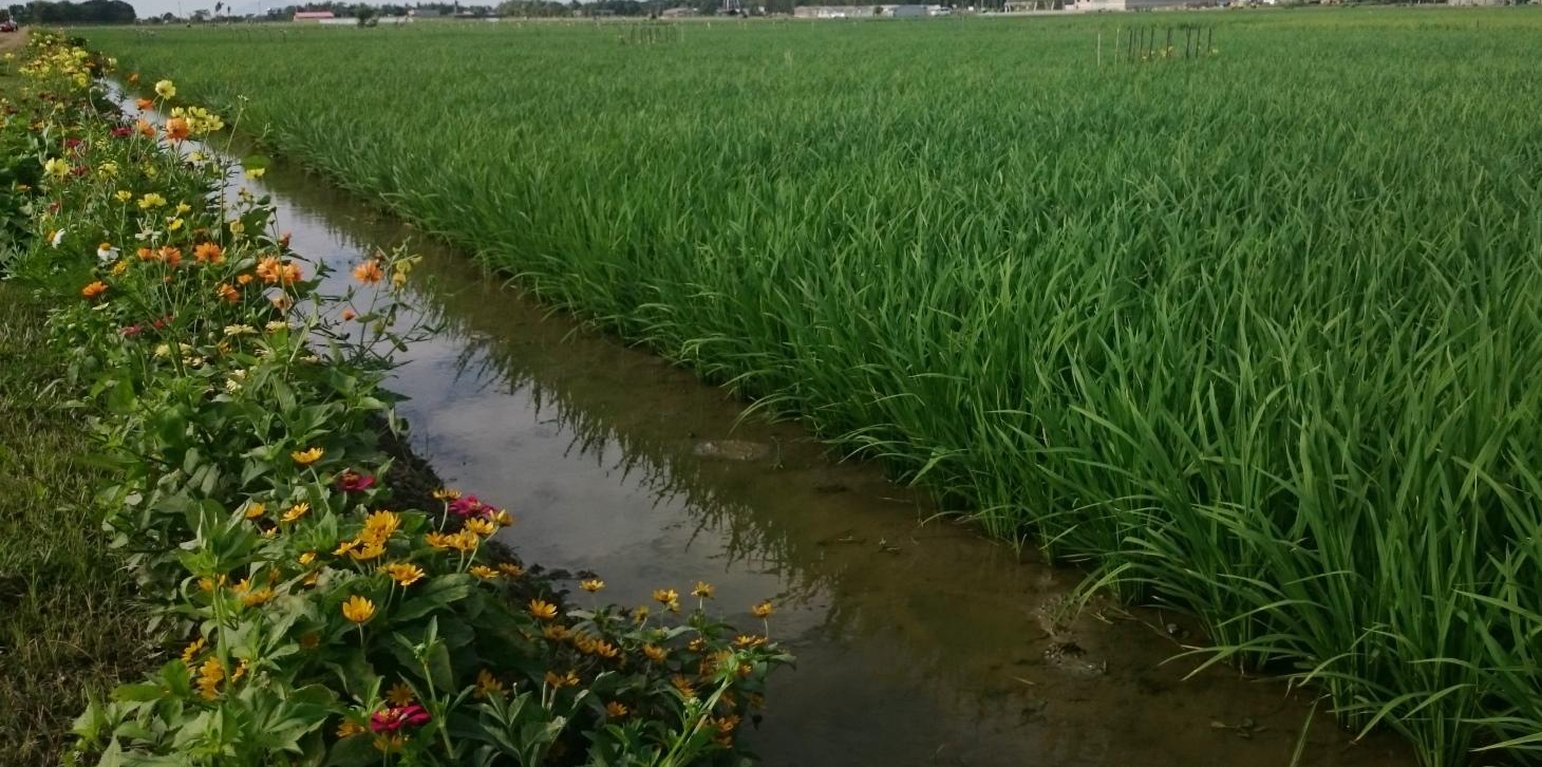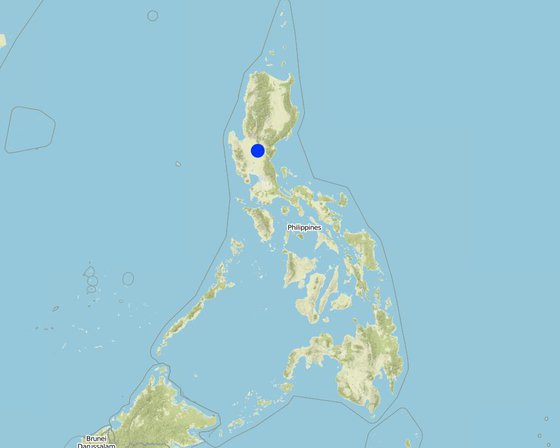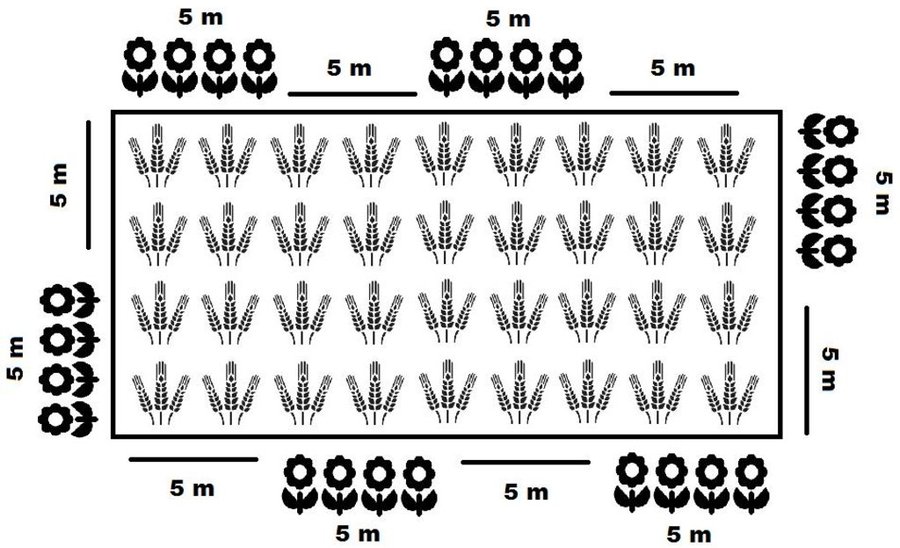



To counteract the negative impact of agricultural intensification, in particular the loss of biodiversity and ecosystem services, more sustainable management for crop land and surrounding habitats is required. ‘Ecological engineering’, in this case meaning the provision of habitats for beneficial arthropods, has recently gained considerable attention as a method of reducing pesticide input, through stimulating biological pest control by natural enemies.
Purpose of the Technology: The concept of ecological engineering is aimed primarily at the regulation of pest species, through the provision of habitats for their natural enemies. However, other ecosystem services, such as pollination and cultural services, may simultaneously be enhanced by using the same measures. One such measure, which is popular and effective in temperate countries where agro-environmental schemes are implemented, is the planting of flower strips as habitats.
In intensively managed tropical rice production systems, biological pest control, pollination services and landscape aesthetics could also benefit from the establishment of flower strips on the bunds within irrigated fields. The specific aim of the technology featured here is to increase biodiversity in rice fields and provide habitats for beneficial organisms such as predators of rice pests (e.g. spiders) or parasitoids (e.g. hymenopteran parasites), which in turn will help to minimize the use of pesticides. An additional benefit is landscape beautification.
Establishment / maintenance activities and inputs: The process comprises collecting seeds of flowering plants (e.g. flowering annuals such as Melampodium divaricatum) and planting them in a nursery. After a month or so they can be transplanted into rice fields on bunds, with a strip size of 0.25 x 5 metres, and a distance between strips of 5 metres (to enable access for farm operations such as fertilizer application). Farmers are requested not to spray insecticides when they test this system. The flowering plants should be pruned during the fallow period in the wet season; and they will require watering during the dry season when rice is cropped. The flower strips will need to be replanted after the rice crop is harvested, if an annual species are chosen.
Natural / human environment: While this SLM technology is for an irrigated rice ecosystem in the center of the island of Luzon in the Philippines, it has already been applied in other rice producing areas – for example in Vietnam and, with some adaptations, should be applicable to irrigated lowland rice production systems throughout Southeast Asia.

สถานที่: Muñoz, Nueva Ecija, ฟิลิปปินส์
ตำนวนการวิเคราะห์เทคโนโลยี:
การเผยแพร่ของเทคโนโลยี: กระจายไปอย่างสม่ำเสมอในพื้นที่ (approx. < 0.1 ตร.กม.(10 เฮกตาร์))
In a permanently protected area?:
วันที่ในการดำเนินการ: น้อยกว่า 10 ปี (ไม่นานนี้)
ประเภทของการแนะนำ




| ปัจจัยนำเข้า | หน่วย | ปริมาณ | ค่าใช้จ่ายต่อหน่วย (USD) | ค่าใช้จ่ายทั้งหมดต่อปัจจัยนำเข้า (USD) | %ของค่าใช้จ่ายที่ก่อให้เกิดขึ้นโดยผู้ใช้ที่ดิน |
| แรงงาน | |||||
| Flowering plant/ nursery / transplanting | Person/day | 13.0 | 7.0 | 91.0 | |
| Trasnportation | - | 1.0 | 41.5 | 41.5 | |
| อุปกรณ์ | |||||
| plastic bags / plot | - | 1.0 | 19.0 | 19.0 | |
| ปุ๋ยและสารฆ่า/ยับยั้งการเจริญเติบโตของสิ่งมีชีวิต (ไบโอไซด์) | |||||
| Compost | kg | 250.0 | 0.12 | 30.0 | |
| Fertilizer | kg | 4.0 | 1.0 | 4.0 | |
| ค่าใช้จ่ายทั้งหมดของการจัดตั้งเทคโนโลยี | 185.5 | ||||
| Total costs for establishment of the Technology in USD | 185.5 | ||||
| ปัจจัยนำเข้า | หน่วย | ปริมาณ | ค่าใช้จ่ายต่อหน่วย (USD) | ค่าใช้จ่ายทั้งหมดต่อปัจจัยนำเข้า (USD) | %ของค่าใช้จ่ายที่ก่อให้เกิดขึ้นโดยผู้ใช้ที่ดิน |
| แรงงาน | |||||
| Flowering plant maintenance | Person/day | 10.0 | 4.0 | 40.0 | |
| ค่าใช้จ่ายทั้งหมดของการบำรุงรักษาสภาพเทคโนโลยี | 40.0 | ||||
| Total costs for maintenance of the Technology in USD | 40.0 | ||||
About 0 since labour constrains increased and workload decreased